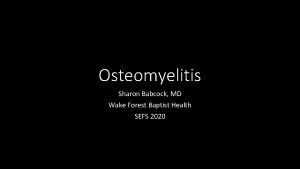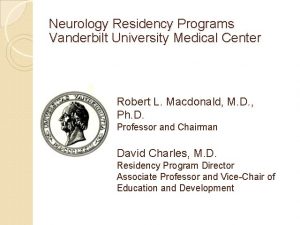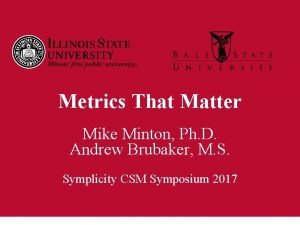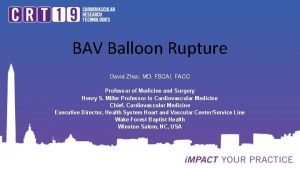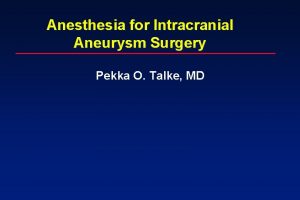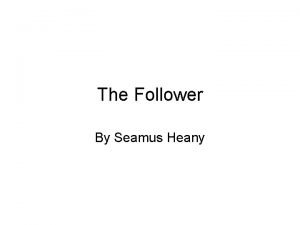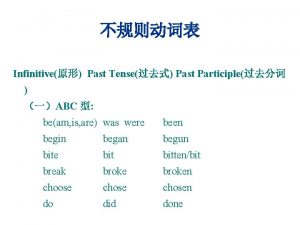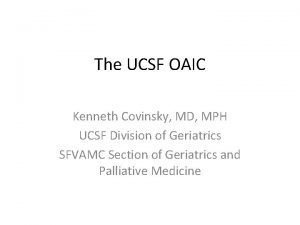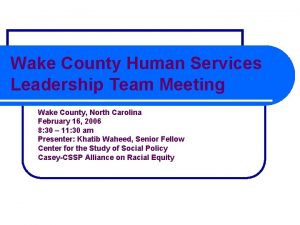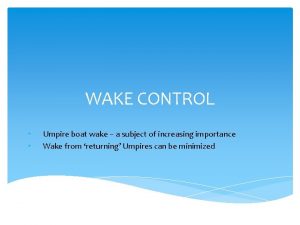Wake Forest OAIC Overview P 30 AG 021332



















- Slides: 19

Wake Forest OAIC Overview P 30 AG 021332

Sticht Center on Aging: Mission Promote the health and independence of older adults by fostering multi-disciplinary collaboration in basic and clinical research, research training, professional education and community outreach.

WFU OAIC: Theme and Aims Theme: Integrating pathways affecting physical function for new approaches to disability treatment and prevention. Aims: • Discover new common pathways contributing to age-related declines in physical function and disability; • Develop, evaluate and refine strategies for disability treatment and prevention; • Translate proven strategies beyond the traditional academic research environment; • Train the next generation of research leaders focused on disability treatment and prevention. Wake Forest School of Medicine

WFU OAIC Organizational Structure Leadership and Administrative Core (Kritchevsky / Kitzman) Research Career Development Core (Kritchevsky / Loeser) Pilot and Exploratory Studies Core (Kitzman / Register) Coordinating Center (High/ Miller) Governance Monthly Exectutive Committee meetings Annual External Advisory Committee Meeting Wake Forest School of Medicine Resource Cores Clinical Research Core (Williamson / Rejeski) Biostatistics and Research Information Systems Core (Miller / Ip) Integrative Biology Core (Nicklas / Delbono) Bio. Imaging Resource Core (Hundley / Carr)

WFU OAIC Integrated Conceptual Model Genes Comorbidity Modifiable Behaviors / Environment Total and Regional Adiposity Limitation Wake Forest School of Medicine Age Restriction Cognitive / Psychological Factors Skeletal Muscle Mass / Function Disability

Obesity / Adiposity and Function: Selected Findings Total Adiposity and Physical Function • Obesity: 1) predicts incident mobility disability more strongly than strength or muscle mass; 2) is as strong a risk factor functional decline as physical inactivity; and 3) blunts the inverse association between physical activity and function. Regional Adipose Tissue Deposition • Pericardial fat is associated with coronary atherosclerosis and the onset of acute coronary events independently of generalized measures of adiposity. • Intraperitoneal fat is associated with the thickening of the descending thoracic artery • Renal sinus fat is associated with refractory hypertension. • Increasing thigh intramuscular fat is associated with declining gait speed.

Weight Loss Interventions in Older Adults: Selected Findings Weight Loss and Exercise Interventions • Moderate weight loss improves physical function in obese and overweight older adults. • Fat mass loss is associated with gain in physical function with intentional weight loss. • The functional benefits of moderate weight loss add to those of aerobic or mixed aerobic and resistive exercise. Optimizing Weight Loss Strategies • Skeletal muscle loss during weight loss can be halved with concomitant resistive exercise or adequate protein intake. • Regained weight after intentional weight loss, has a higher (adverse) fat / lean ratio.

Long-term mortality in persons randomized to weight loss interventions. Adjusted HR (95%CI) TONE (n=585, 101 deaths) 0. 82 (0. 55 -1. 22)a Weight Loss: 4. 4 kg versus 0. 8 kg ADAPT (n=316, 43 deaths) 0. 49 (0. 26 -0. 93)b Weight Loss: 4. 5 kg versus 1. 5 kg Combined (n=901, 144 deaths) 0. 62 (0. 40 -0. 98)c 0. 50 1. 00 Favors Weight loss 1. 5 Favors Non. Weight loss a adjusted for age, gender, race, study site, CVD history, DBP, smoking status, randomization to low sodium intervention b adjusted for age, gender, CVD history, randomization to exercise intervention c adjusted for age, gender, race, CVD history, study (TONE or ADAPT) Shea MK et al. , AJCN 2011

Support Group – Diabetes support and education (n= 2502) ILI Group – 7% weight loss & 175 min physical activity per week (n=2514) Wake Forest School of Medicine


Selected On-going Trials Trial Population Groups Lifestyle Interventions and Independence for Elders High Disability Risk Exercise, Control Look AHEAD Movement and Mobility Ancillary Type II Diabetes Weight Loss + Exercise; Control Cooperative Lifestyle Intervention Program II Obese with CVD or Metabolic Syndrome Weight Loss, Weight Loss + Aerobic Ex; Weight Loss + Resistance Ex Study of the Effects of Caloric Heart Failure with Restriction and Exercise Training Preserved EF (SECRET) Aerobic Ex; Weight Loss; Aerobic Ex + Weight Loss; Control Strength Training for Arthritis Trial High Intensity Resistance Ex; Low Intensity Resistance Ex; Control Knee OA Loss of Fat Tissue and Obese & Sedentary Functional Response to Exercise in Older, Obese Adults Resistance Ex; Resistance + Weight Loss Investigating Fitness in the Elderly Aerobic Ex; Aerobic + Low Weight Loss; Aerobic + High Weight Loss Wake Forest School of Medicine Obese & Sedentary

Integrated Aging Studies Databank and Repository (IASDR) • Holds >135, 000 serum/plasma cryovials and >1260 DNA samples from >3100 research participants enrolled in 29 different OAIC supported studies as well as skeletal muscle, adipose, and cartilage samples • Extensive phenotyping: physical and cognitive function, QOL, body composition • Specific disorders commonly associated with physical disability in older persons: osteoarthritis, diabetes, chronic kidney disease, COPD, heart failure, obesity • Reference group of healthy, age and gender matched subjects (HEALTHY study) • Offered as OAIC resource: www. peppercenter-wfu. org/public/bio_materials. cfm Wake Forest School of Medicine

RCDC • Attract and develop scientists from a variety of backgrounds • Team-based mentoring paradigm • Close integration with the PEC and research support cores • Adding an Emerging Scholar track to develop promising candidates. Wake Forest School of Medicine

WF Pepper Scholars & Emerging Scholars • Kate Saul, Ph. D (Biomedical Engineering) o In Silico shoulder joint modeling to optimize rehabilitation • D. Clark Files, MD (Pulmonary and Critical Care Medicine) o Skeletal muscle dysfunction following acute lung injury in a murine model • Christina Hugenschmidt, Ph. D (Geriatrics) o Patterns of brain network connectivity as related to obesity and physical function • Anthony Molina, Ph. D (Geriatrics) o Mitochondrial function as it relates to mobility in obese older adults • Kathryn E. Callahan, MD (Geriatrics) o Physical and cognitive function as drivers of hospital readmissions • Valarie Wilson, MD (Geriatrics) o 25 (OH) D and age-related cognitive change in the Health ABC study Wake Forest School of Medicine

Pilot Studies Core • Translational, team-based projects with both basic and clinical research • Coordination with RCDC to ensure synergism • Annual RFA; merit-based review • Active fostering and monitoring of progress • 10 -fold return on investment (> $386 K / pilot) Wake Forest School of Medicine

Selected Pilot Projects • Youngmei Liu: Trancriptome and epigenome profiling before and after weight loss intervention in older persons • Denise Houston: Nutritional intervention to prevent weight regain and optimize body composition following caloric restriction • D. Clark Files: Effect of age on recovery from acute lung injury-induced skeletal muscle wasting Wake Forest School of Medicine

Research Dissemination • Functional assessment and exercise in older cancer patients (Klepin) • Functional assessment in pre-operative holding area to predict post-surgical complications (Kim and Groban) • Functional assessment to manage early discharge and reduce re-hospitalizations for Medicare patients with heart failure, pneumonia or MI. (Duncan) • Early mobility in the ICU to prevent post-discharge functional impairment (Morris) Wake Forest School of Medicine

Selected Community Based Programs

Specialized Collaborative Expertise • Clinical trials of novel interventions targeting physical function outcomes: • Conceptualization, design, implementation, and dissemination • Pilot study, single-site and multi-site • Participant recruitment, retention • Behavioral interventions • Animal models of muscle function and aging including non-human primate models • Development and utilization of novel quantitative imaging techniques to identify and modify specific phenotypes Wake Forest School of Medicine
 Oaic privacy training
Oaic privacy training Sharon babcock wake forest
Sharon babcock wake forest Wake forest venice house
Wake forest venice house Williamson medical center pharmacy residency
Williamson medical center pharmacy residency Wfu irb
Wfu irb Wake forest symplicity
Wake forest symplicity Wake forest career services
Wake forest career services David zhao wake forest
David zhao wake forest Woke present tense
Woke present tense Wake county economic development
Wake county economic development Why does juliet note that romeo’s lips are warm?
Why does juliet note that romeo’s lips are warm? Wake up my brain
Wake up my brain Tagaderms
Tagaderms Wake up and pay attention
Wake up and pay attention S0ix modern standby
S0ix modern standby Math 7 plus wake county
Math 7 plus wake county I stumbled in his hob-nailed wake,
I stumbled in his hob-nailed wake, Wake up lucky
Wake up lucky A lion laughing
A lion laughing Hide simple past tense
Hide simple past tense

